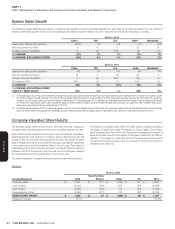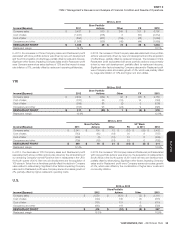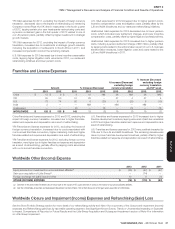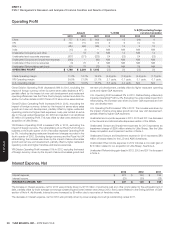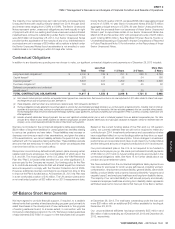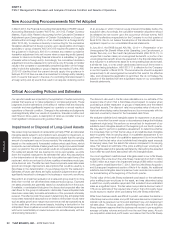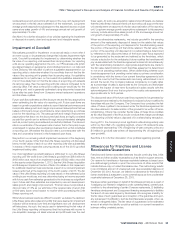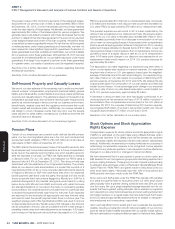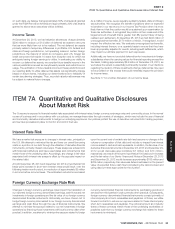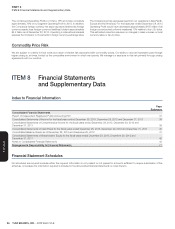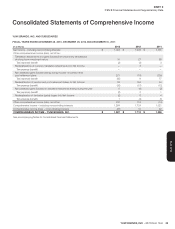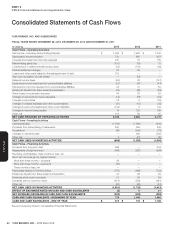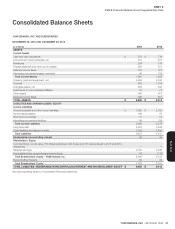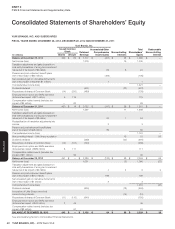Pizza Hut 2013 Annual Report Download - page 128
Download and view the complete annual report
Please find page 128 of the 2013 Pizza Hut annual report below. You can navigate through the pages in the report by either clicking on the pages listed below, or by using the keyword search tool below to find specific information within the annual report.
YUM! BRANDS, INC.-2013 Form10-K32
Form 10-K
PART II
ITEM7Management’s Discussion and Analysis of Financial Condition and Results of Operations
New Accounting Pronouncements Not Yet Adopted
In March 2013, the Financial Accounting Standards Board (“FASB”) issued
Accounting Standards Update (“ASU”) No. 2013-05, Foreign Currency
Matters, (Topic 830): Parent’s Accounting for the Cumulative Translation
Adjustment upon Derecognition of Certain Subsidiaries or Groups of
Assets within a Foreign Entity or of an Investment in a Foreign Entity
(ASU 2013-05), to resolve a diversity in accounting for the cumulative
translation adjustment of foreign currency upon derecognition of a foreign
subsidiary or group of assets. ASU 2013-05 requires the parent to apply
the guidance in Subtopic 830-30 to release any related cumulative
translation adjustment into net income when a reporting entity (parent)
ceases to have a controlling financial interest in a subsidiary or group
of assets within a foreign entity. Accordingly, the cumulative translation
adjustment should be released into net income only if the sale or transfer
results in the complete or substantially complete liquidation of the foreign
entity in which the subsidiary or group of assets had resided. Further, ASU
2013-05 clarified that the parent should apply the guidance in
Subtopic 810-10 if there is a sale of an investment in a foreign entity, including
both (1) events that result in the loss of a controlling financial interest in
a foreign entity and (2) events that result in an acquirer obtaining control
of an acquiree in which it held an equity interest immediately before the
acquisition date. Accordingly, the cumulative translation adjustment should
be released into net income upon the occurrence of those events. ASU
2013-05 is effective prospectively for the Company in our first quarter of
fiscal 2014. We do not believe the adoption of this standard will have a
significant impact on our consolidated financial statements.
In July 2013, the FASB issued ASU No. 2013-11, Presentation of an
Unrecognized Tax Benefit When a Net Operating Loss Carryforward, a
Similar Tax Loss, or a Tax Credit Carryforward Exists (ASU 2013-11), to
require that in certain cases, an unrecognized tax benefit, or portion of an
unrecognized tax benefit, should be presented in the financial statements
as a reduction to a deferred tax asset for a net operating loss carryforward,
a similar tax loss, or a tax credit carryforward when such items exist in
the same taxing jurisdiction. ASU 2013-11 is effective for the Company
in our first quarter of fiscal 2014. The amendments should be applied
prospectively to all unrecognized tax benefits that exist at the effective
date, and retrospective application is permitted. We do not believe the
adoption of this standard will have a significant impact on our consolidated
financial statements.
Critical Accounting Policies and Estimates
Our reported results are impacted by the application of certain accounting
policies that require us to make subjective or complex judgments. These
judgments involve estimations of the effect of matters that are inherently
uncertain and may significantly impact our quarterly or annual results of
operations or financial condition. Changes in the estimates and judgments
could significantly affect our results of operations, financial condition and
cash flows in future years� A description of what we consider to be our
most significant critical accounting policies follows.
Impairment or Disposal of Long-Lived Assets
We review long-lived assets of restaurants (primarily PP&E and allocated
intangible assets subject to amortization) semi-annually for impairment, or
whenever events or changes in circumstances indicate that the carrying
amount of a restaurant may not be recoverable. We evaluate recoverability
based on the restaurant’s forecasted undiscounted cash flows, which
incorporate our best estimate of sales growth and margin improvement based
upon our plans for the unit and actual results at comparable restaurants�
For restaurant assets that are deemed to not be recoverable, we write
down the impaired restaurant to its estimated fair value� Key assumptions
in the determination of fair value are the future after-tax cash flows of the
restaurant, which are reduced by future royalties a franchisee would pay,
and a discount rate� The after-tax cash flows incorporate reasonable sales
growth and margin improvement assumptions that would be used by a
franchisee in the determination of a purchase price for the restaurant�
Estimates of future cash flows are highly subjective judgments and can be
significantly impacted by changes in the business or economic conditions.
We perform an impairment evaluation at a restaurant group level if it is more
likely than not that we will refranchise restaurants as a group. Expected
net sales proceeds are generally based on actual bids from the buyer,
if available, or anticipated bids given the discounted projected after-tax
cash flows for the group of restaurants� Historically, these anticipated bids
have been reasonably accurate estimations of the proceeds ultimately
received� The after-tax cash flows used in determining the anticipated bids
incorporate reasonable assumptions we believe a franchisee would make
such as sales growth and margin improvement as well as expectations as
to the useful lives of the restaurant assets, including a deduction for the
anticipated, future royalties we would receive under a franchise agreement
with terms substantially at market entered into simultaneously with the
refranchising transaction�
The discount rate used in the fair value calculations is our estimate of the
required rate of return that a franchisee would expect to receive when
purchasing a similar restaurant or groups of restaurants and the related
long-lived assets� The discount rate incorporates rates of returns for
historical refranchising market transactions and is commensurate with the
risks and uncertainty inherent in the forecasted cash flows�
We evaluate indefinite-lived intangible assets for impairment on an annual
basis or more often if an event occurs or circumstances change that indicates
impairment might exist. We perform our annual test for impairment of our
indefinite-lived intangible assets at the beginning of our fourth quarter.
We may elect to perform a qualitative assessment to determine whether
it is more likely than not that the fair value of an indefinite-lived intangible
asset is greater than its carrying value. If a qualitative assessment is not
performed, or if as a result of a qualitative assessment it is not more likely
than not that the fair value of an indefinite-lived intangible asset exceeds
its carrying value, then the asset’s fair value is compared to its carrying
value. Fair value is an estimate of the price a willing buyer would pay for
the intangible asset and is generally estimated by discounting the expected
future after-tax cash flows associated with the intangible asset�
Our most significant indefinite-lived intangible asset is our Little Sheep
trademark. We wrote down the Little Sheep trademark from $414 million
to $345 million as a result of an impairment charge of $69 million recorded
in the quarter ended September 7, 2013. See the Little Sheep Acquisition
and Subsequent Impairment section of Note 4 for details. No additional
indefinite-lived intangible asset impairment was recorded as a result of
our annual testing at the beginning of the fourth quarter.
The fair value of the Little Sheep trademark was based on the estimated
price a willing buyer would pay for the asset, and was determined using
a relief from royalty valuation approach that included future estimated
sales as a significant input. This fair value incorporated a discount rate of
13% as our estimate of the required rate of return that a third-party buyer
would expect to receive when purchasing the Little Sheep trademark.
While future business results are difficult to predict, we believe the decline in
Little Sheep same-store sales and profit that were deemed an impairment
indicator will be reversed over time and significant new unit development
will take place. The inputs used in determining the fair value of the Little
Sheep trademark assumed that the business will recover to pre-acquisition
average unit sales volumes and profit over the next three years. At such
pre-acquisition sales and profit levels, we believe that the Little Sheep




